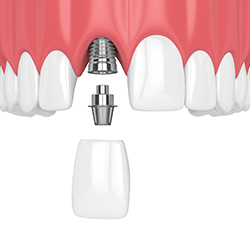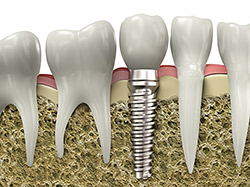 What are Dental Implants?
What are Dental Implants?
Whether you have missing or damaged teeth, dental implants are the gold standard in tooth replacement to restore your mouth’s functionality and elevate your quality of life. An implant is a permanent tooth replacement that looks, feels, and functions like natural teeth.
Dental implants are advanced artificial tooth roots made up of three parts:
1. Implant
2. Abutment
3. Crown
An implant is a synthetic tooth root in the shape of a post (looks like a screw) that is surgically placed into the jawbone. The “root” is usually made of titanium: the same material used in many replacement hips and knees, and a metal that is well-suited to pairing with human bone. An abutment is placed on top of the implant, which serves as a connector between the screw and the crown. Finally, the crown is attached. The crown is designed to match the color and functionality of your real teeth.
Dental implants live beneath the gum, while the prosthetic tooth/crown sits on top. Because of this, they look, feel, and function just like natural teeth, which is why they are considered the gold standard for tooth replacement.
The ideal candidate for implants is a non-smoker who has good oral health, including a sufficient amount of bone in the jaw, and healthy gums with no sign of gum disease.
Benefits of Dental Implants
1. Optimal Performance - Dental implants behave like real teeth to restore full chewing power and performance.
2. Long-Lasting Solution - Since dental implants are biocompatible and integrate with the jawbone, they can last a lifetime with proper care.
3. Natural Appearance - Dental implants are designed to match the color of your surrounding teeth and fit perfectly in the gap.
4. Improved Facial Structure & Prevents Bone Loss - Dental implants provide necessary facial and bone support, which helps to prevent bone loss.
5. Stabilizes and Protects Adjacent Teeth - Dental implants provide stability to prevent gaps from causing adjacent teeth to shift and become crooked.
6. High Success Rate - If you are a good candidate for dental implants, there is a high success rate and satisfaction.
7. Enhanced Speech Capabilities - Dental implants feel and function like real teeth, allowing you to talk easily and naturally.
8. Reduces the Risk of Cavities - Dental implants have no organic material, therefore cannot decay, so you do not have to worry about cavities.
9. Boosts Confidence - Dental implants restore your smile, contributing to more confidence and a better quality of life.
Immediate vs. Staged Implants
An immediate implant is when the doctor can perform the implant placement in the same surgery that the tooth is removed. This can sometimes be an option with smaller, single-rooted teeth towards the front of the mouth. But, certain criteria must be met. Dr. Pete can never guarantee an immediate implant until accessing the bone after the tooth is removed. If an implant is placed at the time of tooth extraction, proper healing time is still required (typically four months) before your dentist can take impression and begin the crown process.
A staged implant is when the tooth needs to be removed first and the proper healing time is required before an implant can be placed. This is more than often the case with larger teeth, teeth that have had a root canal, or teeth that require bone grafting. The timeline for a staged implant is as following:
STAGED IMPLANT TIMELINE
The first step to restoring your smile with dental implants is scheduling a consultation with Dr. Pete. This consultation is approximately an hour. During this time, Dr. Pete will discuss your medical history in detail and will learn more about your dental goals. The team may need to take additional images. Dr. Pete will discuss, in detail, the images as well as all the steps included in the implant process and evaluate your candidacy for dental implants. Together, you will determine if this pathway is the best solution for your oral needs. From here, the two of you will build a personalized treatment plan. This discussion will also include sedation options, if desired.
After your detailed clinical discussion with Dr. Pete regarding the surgical aspects of the implant process, you will then meet with the Patient Care Coordinator to discuss financial impacts. If you have dental insurance, they will also discuss your estimated insurance coverage vs out of pocket expenses for each stage of the implant process.
Once you have decided to proceed with Dr. Pete and team down the implant journey, below is what you can expect regarding your time with our team. It is important to note that dental implant and tooth restoration can take several months, sometimes up to a year, ensuring enough time for healing and the growth of new bone in your jaw. Rest assured, this time frame is worth the wait, as your smile will be transformed after your implant process is complete!
- STAGE 1 - Tooth Extraction / Bone Grafting
The tooth will be extracted. It is possible that the bone will be grafted to ensure there is ample width and height for the implant placement. The extraction/grafting surgical appointment could be anywhere from 30 minutes to a few hours, depending on the number of teeth involved and complexity of the case.
- STAGE 2 - Post Operative Follow-Up & Suture Removal
Approximately two weeks after your extraction/grafting, it is possible to have a short post-operative appointment for Dr. Pete to evaluate the extraction and grafting site and remove the sutures.

- STAGE 3 - CBCT 3D Imaging & Implant Placement
Approximately four months after Stage 1 (extraction/graft), you will come back to the office for a CT scan. This will allow Dr. Pete to measure bone width and height. He will place a digital implant on your image to decide the appropriate implant size. At this appointment, it highly possible (and the timeline plans as such) that you are ready for implant placement.
Dr. Pete will use a specially-designed tool to drill a hole into the bone, which creates space for the implant. Next, he will gently insert the implant screw into the bone according to your treatment specifications. He will also add a healing cap (a flat abutment) to allow the implant to heal undisturbed and keep bacteria out from the inside of the implant. The gums are then closed, and the healing process begins. You will likely not see any part of the implant. There will not be a crown on until the implant is fully healed, but you can continue to wear temporary fixtures, such as a flipper or partial, during this phase if desired.
- STAGE 4 - Post Operative Follow-Up / Healing
Approximately two weeks after your implant was placed (Stage 3), it is likely that we will request to see you for another post-operative evaluation. The next three to six months involve healing and osseointegration.
- STAGE 5 - 2D Imaging & Uncovering
After ~ four months from Stage 3 (Implant Placement), you will come back for a 2D image/Pano. This will allow Dr. Pete to see if your bone has grown properly around the implant, a process called integration. If Dr. Pete is pleased with the integration of the bone graft and implant, he will perform the “uncovering”. At this appointment, he will numb the area of the implant and remove a small amount of the tissue directly over the top of the implant. Dr. Pete will switch the abutment for one a few millimeters taller that will now be visible to you. This is how your general dentist accesses your implant to place the crown.
After this appointment, your general dentist will be sent all of the specifications of your implant along with the latest X-ray we have so they can take impressions and create the crown (or tooth) that will be secured to your implant, restoring your smile.
- STAGE 6 - Tooth Restoration
Once the dental implant(s) have fully fused to the bone (a process referred to as osseointegration), the restoration process can occur and you are ready for your crown! You will now proceed with treatment with your general dentist. Most general dentists prefer a minimum of a week of healing time after the uncovering before they start the process of impressions to create the crown. It is also critical that you maintain a regular cleaning/maintenance schedule with your general dentist to ensure a successful life for your implant!
- STAGE 7 - Maintenance
Consider your replacement teeth to be the same as natural teeth. They require the same daily brushing and flossing, and the same amount of regular checkups. Just like your natural teeth, the better you take care of your replacements, the longer they will last. Once your dental implant restoration is completed, it is important to keep the area clean and infection-free. Dental implants can accumulate plaque and tartar just as teeth can. Whether you have just one tooth replaced by an implant or several, a professional cleaning schedule with your general dentist will be necessary to keep your implants healthy. The time interval for these professional cleanings will be determined by your individual needs.
Quitting smoking is also critical to the healing and restoration success.
SINGLE OR MULTIPLE IMPLANTS
Implants are versatile. If you are only missing one tooth, one implant plus one replacement tooth will do the trick. If you are missing several teeth in a row, a few strategically placed implants can support a permanent bridge (a set of replacement teeth). Similarly, if you have lost all of your teeth, a full bridge or full denture can be permanently fixed in your mouth with a strategic number of implants.
ADVANTAGES OVER DENTURES OR BRIDGES
Conventional bridges and dentures are not fixed to the bone, and can therefore be unstable. This can make it difficult to eat or smile with confidence. Implants not only look more natural, but feel and act more like normal teeth, with a stronger biting force. And because they don't directly rely on neighboring teeth for support, implants don't compromise the health of your natural teeth. In fact, bridges are only expected to last seven to ten years, even less with root canals, whereas implants will typically last a lifetime.
IMPLANT SUPPORTED DENTURES
Implant-supported dentures are over-dentures fixed to the gums by mini implants. For patients with an uncomfortable or loose-fitting dentures, stabilizing it with mini implants can be a more comfortable and functional solution.
Mini implants are placed in the jaw, where they are anchored firmly in the surrounding bone. Attachments are placed in the underside of the denture that connects to the implants. When placed in the mouth, the denture snaps onto the implants, keeping it stable and secure.
ALL-ON-4®
Maintain optimal oral function and aesthetics with All-on-4 same-day teeth replacement. Using state-of-the-art technology, All-on-4 treatment replaces traditional dentures, which can be uncomfortable, inconvenient, and poorly fitted. All-on-4 turns problematic chewing and speaking into relics of the past.
Using only four dental implants to attach a full dental restoration, your doctor can give you the stable, functional, and cosmetic solution you've been looking for. Best of all, your dentures can be placed on the same day as your implants, so you don't have to wait to get the restored smile you deserve.



